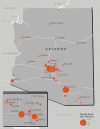Enhanced Surveillance for Coccidioidomycosis, 14 US States, 2016
- PMID: 30014837
- PMCID: PMC6056093
- DOI: 10.3201/eid2408.171595
Enhanced Surveillance for Coccidioidomycosis, 14 US States, 2016
Abstract
Although coccidioidomycosis in Arizona and California has been well-characterized, much remains unknown about its epidemiology in states where it is not highly endemic. We conducted enhanced surveillance in 14 such states in 2016 by identifying cases according to the Council of State and Territorial Epidemiologists case definition and interviewing patients about their demographic characteristics, clinical features, and exposures. Among 186 patients, median time from seeking healthcare to diagnosis was 38 days (range 1-1,654 days); 70% had another condition diagnosed before coccidioidomycosis testing occurred (of whom 83% were prescribed antibacterial medications); 43% were hospitalized; and 29% had culture-positive coccidioidomycosis. Most (83%) patients from nonendemic states had traveled to a coccidioidomycosis-endemic area. Coccidioidomycosis can cause severe disease in residents of non-highly endemic states, a finding consistent with previous studies in Arizona, and less severe cases likely go undiagnosed or unreported. Improved coccidioidomycosis awareness in non-highly endemic areas is needed.
Keywords: Coccidioides; United States; coccidioidomycosis; endemic diseases; epidemiology; fungal infections; fungi; surveillance; valley fever.
Figures


References
-
- Council of State and Territorial Epidemiologists. Coccidioidomycosis/Valley fever (Coccidioides spp.) 2011. case definition [cited 2017 Apr 12]. https://wwwn.cdc.gov/nndss/conditions/coccidioidomycosis/case-definition...
MeSH terms
LinkOut - more resources
Full Text Sources
Other Literature Sources
Medical

